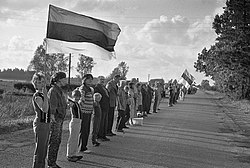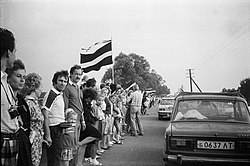Baltic Way
| Part of theSinging Revolution,theRevolutions of 1989,and theDissolution of the Soviet Union | |
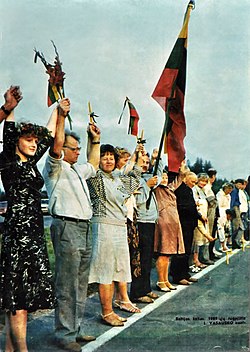 | |
| Date | 23 August 1989 |
|---|---|
| Location | Estonia,LatviaandLithuania(three countries occupied by theSoviet Union) |
| Also known as | Baltic Chain of Freedom |
| Cause | 50th anniversary of theMolotov–Ribbentrop Pact |
| Participants | About 2 million people |
| Outcome | Independence of the three countries was regained by August 1991 |
TheBaltic Way(Lithuanian:Baltijos kelias;Latvian:Baltijas ceļš;Estonian:Balti kett) orBaltic Chain(also "Chain of Freedom"[1]) was a peaceful political demonstration that occurred on 23 August 1989. Approximately two million people joined their hands to form ahuman chainspanning 690 kilometres (430 mi) across the threeBaltic statesofEstonia,LatviaandLithuania,which at the time wereoccupied and annexed by the USSRand had a combined population of approximately eight million.[2]The central government in Moscow considered the three Baltic countriesconstituent republicsof theSoviet Union.
The demonstration originated in "Black Ribbon Day"protests held in the western cities in the 1980s. It marked the 50th anniversary of theMolotov–Ribbentrop Pact,in which Poland, Finland, Estonia, Latvia, Lithuania, and Romania were (as "spheres of influence") divided between the Soviet Union andNazi Germany.The Soviet-Nazi pact led to the outbreak ofWorld War IIin September 1939 and theSoviet invasion and occupation of the Baltic countriesin June 1940.
The 1989 event was organised by the Baltic pro-independence movements:Rahvarinneof Estonia, theTautas fronteof Latvia, andSąjūdisof Lithuania, to draw global attention by demonstrating a popular desire for independence and showcasing solidarity among the three nations. It has been described as an effective publicity campaign, and an emotionally captivating and visually stunning scene.[3][4]
The event presented an opportunity for the Baltic activists to publicise the Soviet rule and position the question of Baltic independence not only as a political matter, but also as a moral issue. The Soviet authorities responded to the event with intense rhetoric,[3]but failed to take any constructive actions that could bridge the widening gap between the Baltic republics and the rest of the Soviet Union. Seven months after the protest Lithuania became the first Soviet republic to declare independence.
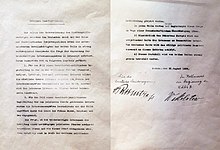
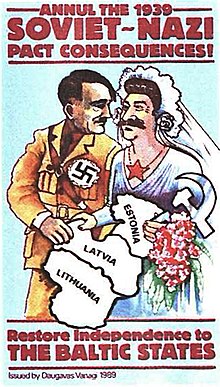
After theRevolutions of 1989,23 August has become an official remembrance day both in the Baltic countries, in theEuropean Unionand in other countries, known as the Black Ribbon Day or as theEuropean Day of Remembrance for Victims of Stalinism and Nazism.
Background[edit]
Baltic stance[edit]
The Soviet Union denied the existence of the secret protocols to theMolotov–Ribbentrop Pact,even though they were widely published by western scholars after surfacing during theNuremberg Trials.[5]Soviet propagandaalso maintained that there was no occupation and that all three Baltic states voluntarily joined the Union – thePeople's Parliamentsexpressed people's will when they petitioned theSupreme Soviet of the Soviet Unionto be admitted into the Union.[6]The Baltic states claimed that they were forcefully and illegally incorporated into the Soviet Union. Popular opinion was that the secret protocols proved that the occupation was illegal.[7]
Such an interpretation of the Pact had major implications in the Baltic public policy. If Baltic diplomats could link the Pact and the occupation, they could claim that the Soviet rule in the republics had no legal basis and therefore all Soviet laws werenull and voidsince 1940.[8]Such a position would automatically terminate the debate over reforming Baltic sovereignty or establishing autonomy within the Soviet Union – the states neverde jurebelonged to the union in the first place.[9]This would open the possibility of restoring legal continuity of the independent states that existed in the interwar period. Claiming all Soviet laws had no legal power in the Baltics would also cancel the need to follow theConstitution of the Soviet Unionand other formal secession procedures.[10]
In anticipation of the 50th anniversary of the Molotov–Ribbentrop Pact, tensions were rising between the Baltics and Moscow. LithuanianRomualdas Ozolasinitiated a collection of 2 million signatures demanding withdrawal of theRed Armyfrom Lithuania.[11]TheCommunist Party of Lithuaniawas deliberating the possibility of splitting off from theCommunist Party of the Soviet Union.[12]On 8 August 1989, Estonians attempted to amend election laws to limit voting rights of new immigrants (mostly Russian workers).[13]This provoked mass strikes and protests of Russian workers. Moscow gained an opportunity to present the events as an "inter-ethnic conflict"[14]– it could then position itself as "peacemaker" restoring order in a troubled republic.[15]
The rising tensions in anticipation of the protest spurred hopes that Moscow would react by announcing constructive reforms to address the demands of the Baltic people.[16]At the same time fears grew of violent clampdown.Erich HoneckerfromEast GermanyandNicolae CeaușescufromRomaniaoffered the Soviet Union military assistance in case it decided to use force and break up the demonstration.[17]
Soviet response[edit]
On 15 August 1989, in response to worker strikes in Estonia,Pravda,the official daily newspaper of the Soviet Union, published sharp criticism of "hysteria" driven by "extremist elements" pursuing selfish "narrow nationalist positions" against the greater benefit of the entire Soviet Union.[13]On 17 August, theCentral Committee of the Communist Party of the Soviet Unionpublished a project of new policy regarding the union republics inPravda.However, this project offered few new ideas: it preserved Moscow's leadership not only in foreign policy and defense, but also in economy, science, and culture.[18]The project made a few cautious concessions: it proposed the republics have the right to challenge national laws in a court (at the time all three Baltic states had amended their constitutions giving theirSupreme Sovietsthe right to veto national laws)[19]and the right to promote their national languages to the level of the official state language (at the same time the project emphasised the leading role of the Russian language).[18]The project also included laws banning "nationalist and chauvinist organisations," which could be used to persecute pro-independence groups in the Baltics,[19]and a proposal to replace theTreaty on the Creation of the USSRof 1922 with a new unifying agreement, which would be part of the Soviet constitution.[18]
On 18 August,Pravdapublished an extensive interview withAlexander Nikolaevich Yakovlev,[20]chairman of a 26-member commission set up by theCongress of People's Deputiesto investigate theMolotov–Ribbentrop Pactand its secret protocols.[5]During the interview, Yakovlev admitted that the secret protocols were genuine. He condemned the protocols, but maintained that they had no impact on the incorporation of the Baltic states.[21]Thus Moscow reversed its long-standing position that the secret protocols did not exist or were forgeries, but did not concede that events of 1940 constituted an occupation. It was clearly not enough to satisfy the Baltics and on 22 August, a commission of theSupreme Soviet of the Lithuanian SSRannounced that the occupation in 1940 was a direct result of the Molotov–Ribbentrop Pact and therefore illegal.[22]It was the first time that an official Soviet body challenged the legitimacy of the Soviet rule.[23][24]
Protest[edit]
Preparation[edit]
In the light ofglasnostandperestroika,street demonstrations had been increasingly growing in popularity and support. On 23 August 1986, Black Ribbon Day demonstrations were held in 21 western cities includingNew York,Ottawa,London,Stockholm,Seattle,Los Angeles,Perth,andWashington, DCto bring worldwide attention to human rights violations by the Soviet Union. In 1987, Black Ribbon Day protests were held in 36 cities includingVilnius,Lithuania. Protests against the Molotov Ribbentrop Pact were also held in Tallinn and Riga in 1987. In 1988, for the first time, such protests were sanctioned by the Soviet authorities and did not end in arrests.[8]The activists planned an especially large protest for the 50th anniversary of the Molotov–Ribbentrop Pact in 1989. It is unclear when and by whom the idea of a human chain was advanced. It appears that the idea was proposed during a trilateral meeting inPärnuon 15 July.[25]An official agreement between the Baltic activists was signed inCēsison 12 August.[26]Local Communist Party authorities approved the protest.[27]At the same time several different petitions, denouncing Soviet occupation, were gathering hundreds of thousands of signatures.[28]
The organisers mapped out the chain, designating specific locations to specific cities and towns to make sure that the chain would be uninterrupted. Free bus rides were provided for those who did not have other transportation.[29]Preparations spread across the country, energising the previously uninvolved rural population.[30]Some employers did not allow workers to take the day off from work (23 August fell on a Wednesday), while others sponsored the bus rides.[29]On the day of the event, special radio broadcasts helped to coordinate the effort.[27]Estonia declared a public holiday.[31]
The Baltic pro-independence movements issued a joint declaration to the world and European community in the name of the protest. The declaration condemned the Molotov–Ribbentrop Pact, calling it a criminal act, and urged declaration that the pact was "null and void from the moment of signing."[32]The declaration said that the question of the Baltics was a "problem of inalienablehuman rights"and accused the European community of" double standards "and turning a blind eye to the" last colonies of Hitler–Stalin era. "[32]On the day of the protest,Pravdapublished an editorial titled "Only the Facts." It was a collection of quotes from pro-independence activists intended to show the unacceptable anti-Soviet nature of their work.[33]
-
Diagram assigning each city and town a stretch of the road to cover
-
People carried portable radios to coordinate the efforts and badges to show unity of the three states
-
Traffic jam on theA2 highway
Human chain[edit]


The chain connected the three Baltic capitals –Vilnius,Riga,andTallinn.It ran from Vilnius along theA2 highwaythroughŠirvintosandUkmergėtoPanevėžys,then along theVia BalticathroughPasvalystoBauskain Latvia and throughIecavaandĶekavatoRiga(Bauska highway,Ziepniekkalna street, Mūkusalas street,Stone bridge,Kaļķu street, Brīvības's street) and then along roadA2,throughVangaži,Sigulda,Līgatne,Mūrnieki andDrabeši,toCēsis,from there, through Lode, toValmieraand then throughJēči,Lizdēni,Rencēni,Oleri,RūjienaandĶoņito Estonian townKarksi-Nuiaand from there throughViljandi,TüriandRaplato Tallinn.[34][35]The demonstrators peacefully linked hands for 15 minutes at 19:00 local time (16:00GMT).[6]Later, a number of local gatherings and protests took place. In Vilnius, about 5,000 people gathered in theCathedral Square,holding candles and singing national songs, includingTautiška giesmė.[36]Elsewhere, priests held masses or rang church bells. Leaders of the Estonian and Latvian Popular Fronts gathered on the border between their two republics for a symbolic funeral ceremony, in which a giant black cross was set alight.[31]The protesters held candles and pre-war national flags decorated with black ribbons in memory of the victims of the Soviet terror:Forest Brothers,deportees toSiberia,political prisoners, and other "enemies of the people."[24][36]
In Moscow'sPushkin Square,ranks of special riot police were employed when a few hundred people tried to stage a sympathy demonstration.TASSsaid 75 were detained for breaches of the peace, petty vandalism, and other offences.[36]About 13,000 demonstrated in theMoldavian Soviet Socialist Republicwhich was also affected by the secret protocol.[37]A demonstration was held by the BalticémigréandGermansympathizers in front of the Soviet embassy inBonn,thenWest Germany.
| Measure[38] | Estonia | Latvia | Lithuania |
|---|---|---|---|
| Total population (1989) | 1.6M | 2.7M | 3.7M |
| Indigenous population (1959) | 75% | 62% | 79% |
| Indigenous population (1989) | 61% | 52%[39] | 80% |
Most estimates of the number of participants vary between one and two million.ReutersNews reported the following day that about 700,000 Estonians and 1,000,000 Lithuanians joined the protests.[37]The Latvian Popular Front estimated an attendance of 400,000.[40]Prior to the event, the organisers expected an attendance of 1,500,000 out of the about 8,000,000 inhabitants of the three states.[36]Such expectations predicted 25–30% turnout among the native population.[30]According to the official Soviet numbers, provided by TASS, there were 300,000 participants in Estonia and nearly 500,000 in Lithuania.[36]To make the chain physically possible, an attendance of approximately 200,000 people was required in each state.[6]Video footage taken from airplanes and helicopters showed an almost continuous line of people across the countryside.[23]
-
In Estonia
-
In Latvia
-
In Lithuania
Immediate aftermath[edit]
"Matters have gone far. There is a serious threat to the fate of theBaltic peoples.People should know the abyss into which they are being pushed by their nationalistic leaders. Should they achieve their goals, the possible consequences could be catastrophic to these nations. A question could arise as to their very existence. "
Declaration of theCentral Committeeon the situation in the Soviet Baltic republics, 26 August[41]
On 26 August 1989, a pronouncement from the Central Committee of the Communist Party was read during the opening 19 minutes ofVremya,the main evening news program on Soviet television.[42]It was a sternly worded warning about growing "nationalist, extremist groups" which advanced "anti-socialist and anti-Soviet" agendas.[43]The announcement claimed that these groups discriminated against ethnic minorities and terrorised those still loyal to Soviet ideals.[43]Local authorities were openly criticised for their failure to stop these activists.[33]The Baltic Way was referred to as a "nationalist hysteria." According to the pronouncement, such developments would lead to an "abyss" and "catastrophic" consequences.[28]The workers and peasants were called on to save the situation and defend Soviet ideals.[33]Overall, there were mixed messages: while indirectly threatening the use of force, it also placed hopes that the conflict could be solved via diplomatic means. It was interpreted that the Central Committee had not yet decided which way to go and had left both possibilities open.[44]The call to pro-Soviet masses illustrated that Moscow believed it still had a significant audience in the Baltics.[33]Sharp criticism of Baltic Communist Parties was interpreted as signalling that Moscow would attempt to replace their leadership.[44]However, almost immediately after the broadcast, the tone in Moscow began to soften[45]and the Soviet authorities failed to follow up on any of their threats.[46]Eventually, according to historianAlfred Erich Senn,the pronouncement became a source of embarrassment.[46]
President of the United StatesGeorge H. W. Bush[47]and chancellor ofWest GermanyHelmut Kohlurged peaceful reforms and criticised the Molotov–Ribbentrop Pact.[48]On 31 August, the Baltic activists issued a joint declaration toJavier Pérez de Cuéllar,Secretary-General of the United Nations.[49]They claimed to be under threat of aggression and asked for an international commission to be sent to monitor the situation. On 19–20 September, the Central Committee of the Communist Party convened to discuss the nationality question – somethingMikhail Gorbachevhad been postponing since early 1988.[50]The plenum did not specifically address the situation in the Baltic states and reaffirmed old principles regarding the centralised Soviet Union and the dominant role of theRussian language.[51]It did promise some increase in autonomy, but was contradictory and failed to address the underlying reasons for the conflict.[52]
Evaluation[edit]


The human chain helped to publicise the Baltic cause around the world and symbolised solidarity among the Baltic peoples.[53]The positive image of the non-violentSinging Revolutionspread among the western media.[54]The activists, includingVytautas Landsbergis,used the increased exposure to position the debate over Baltic independence as a moral, and not just political question: reclaiming independence would be restoration of historical justice and liquidation of Stalinism.[55][56]It was an emotional event, strengthening the determination to seek independence. The protest highlighted that the pro-independence movements, established just a year before, became more assertive and radical: they shifted from demanding greater freedom from Moscow to full independence.[23]
In December 1989, theCongress of People's Deputiesaccepted andMikhail Gorbachevsigned the report byYakovlev'scommission condemning the secret protocols of the Molotov–Ribbentrop Pact.[57]In February 1990, the first free democratic elections to theSupreme Sovietstook place in all three Baltic states and pro-independence candidates won majorities. On 11 March 1990, within seven months of the Baltic Way, Lithuania became the first Soviet state to declare independence. The independence of all three Baltic states was recognised by most western countries by the end of 1991.
This protest was one of the earliest and longest unbrokenhuman chainsin history. Similar human chains were later organised in many East European countries and regions of theUSSRand, more recently, inTaiwan(228 Hand-in-Hand Rally) andCatalonia(Catalan Way). On the 30th anniversary of the Baltic Way, a 30-mile (48 km) human chain called theHong Kong Waywas formed during the2019–20 Hong Kong protests.[58]On August 23, 2020, the Baltic states did areenactment including Belarusfor belarusian activists. Documents recording the Baltic Way were added toUNESCO'sMemory of the World Registerin 2009 in recognition of their value in documenting history.[59][60]
See also[edit]
- The Baltics Are Waking Up
- Hands Across America(1986)
- 71st anniversary of Ukrainian unification(1990)
- 228 Hand-in-Hand rallyinTaiwan(2004)
- Catalan Way(2013)
- Hong Kong Way(2019)
Notes[edit]
- ^Wolchik, Sharon L.; Jane Leftwich Curry (2007).Central and East European Politics: From Communism to Democracy.Rowman & Littlefield. p. 238.ISBN978-0-7425-4068-2.
- ^Aliide Naylor,The Shadow in the East: Vladimir Putin and the New Baltic Front(2020).
- ^abDreifelds, Juris (1996).Latvia in Transition.Cambridge University Press. pp. 34–35.ISBN0-521-55537-X.
- ^Anušauskas 2005,p. 619.
- ^abUnited Press International(12 August 1989). "Baltic Deal / Soviets Publish Secret Hitler Pact".The San Francisco Chronicle.
- ^abcConradi, Peter (18 August 1989). "Hundreds of Thousands to Demonstrate in Soviet Baltics".Reuters News.
- ^Senn 1995,p. 33.
- ^abDejevsky, Mary (23 August 1989). "Baltic Groups Plan Mass Protest; Latvia, Lithuania and Estonia's Struggle for Independence".The Times.
- ^Senn 1995,p. 91.
- ^Conradi, Peter (16 August 1989). "Lithuania's Communist Party Considers Split from Moscow".Reuters.
- ^abFisher, Matthew (16 August 1989). "Moscow Condemns 'Hysteria' in Baltics".The Globe and Mail.
- ^Blitz, James (16 August 1989). "Moscow Voices Growing Concern Over Ethnic Conflict".Financial Times.p. 2.
- ^Senn 1995,p. 30.
- ^Ashbourne, Alexandra (1999).Lithuania: The Rebirth of a Nation, 1991–1994.Lexington Books. p. 24.ISBN0-7391-0027-0.
- ^ab"Soviet party leaders accept Baltic demand".Houston Chronicle.Associated Press. 17 August 1989.
- ^Vardys, Vytas Stanley; Judith B. Sedaitis (1997).Lithuania: The Rebel Nation.Westview Series on the Post-Soviet Republics. Westview Press. pp. 150–151.ISBN0-8133-1839-4.
- ^Remnick, David (19 August 1989). "Kremlin Acknowledges Secret Pact on Baltics; Soviets Deny Republics Annexed Illegally".The Washington Post.
- ^Senn 1995,p. 66.
- ^abcFein, Esther B. (24 August 1989)."Baltic Citizens Link Hands to Demand Independence".The New York Times.
- ^abDobbs, Michael(24 August 1989). "Huge Protest 50 Years After Soviet Seizure". The San Francisco Chronicle.
- ^Anušauskas 2005,p. 617.
- ^abDobbs, Michael(24 August 1989). "Baltic States Link in Protest 'So Our Children Can Be Free'; 'Chain' Participants Decry Soviet Takeover".The Washington Post.
- ^abImse, Ann (27 August 1989)."Baltic Residents Make Bold New Push For Independence".Associated Press.[permanent dead link]
- ^abAlanen 2004,p.100
- ^abAlanen 2004,p.78
- ^abLodge, Robin (23 August 1989). "More than Two Million Join Human Chain in Soviet Baltics".Reuters News.
- ^ab"The Baltic Way"(PDF).Estonian, Latvian and Lithuanian National Commissions for UNESCO. 17 August 1989. Archived fromthe original(PDF)on 23 July 2011.Retrieved20 August2009.
- ^abcdSenn 1995,p. 67.
- ^""Tautas frontes muzeja ekspozīcijas" Atmoda – LTF – Neatkarība "mākslinieciskā risinājuma realizācija""[ “People's Front Museum expositions" Awakening – LTF – Independence "realization of an artistic solution” ].www.ltfmuz.lv.Archived fromthe originalon 2013-12-26.Retrieved2013-07-10.
- ^"The Baltic Way".Archived fromthe originalon 25 July 2013.Retrieved10 July2013.
- ^abcdeImse, Ann (23 August 1989). "Baltic Residents Form Human Chain in Defiance of Soviet Rule". Associated Press.
- ^abLodge, Robin (23 August 1989). "Human Chain Spanning: Soviet Baltics Shows Nationalist Feeling".Reuters News.
- ^Dobbs, Michael(27 August 1989). "Independence Fever Sets Up Confrontation".The Washington Post.
- ^Mezs, Ilmars (1994).The Ethnic Aspects of Population Change in Latvia After Independence(Master's thesis). Western Michigan University. p. 11.
- ^"Pravda chides Baltic activists".Tulsa World.Associated Press. 24 August 1989.
- ^Misiunas, Romuald J.; Rein Taagepera (1993).The Baltic States: Years of Dependence 1940–1990(expanded ed.). University of California Press. p.328.ISBN0-520-08228-1.
- ^Fein, Esther B. (27 August 1989)."Moscow Condemns nationalist 'Virus' in 3 Baltic Lands".The New York Times.
- ^abRemnick, David (27 August 1989). "Kremlin Condemns Baltic Nationalists; Soviets Warn Separatism Risks 'Disaster'".The Washington Post.
- ^abSenn 1995,p. 69.
- ^Hines, Cragg(29 August 1989). "Bush Urges Restraint in Baltics Dealings".Houston Chronicle.
- ^Senn 1995,p. 70.
- ^Winfrey, Paul (25 September 1989). "Flaws in Soviet Plan to End Strife: Moscow's Attempt to Cope with Nationalist Turmoil".Financial Times.
- ^Taagepera, Rein (1993).Estonia: Return to Independence.Westview Series on the Post-Soviet Republics. Westview Press. p. 157.ISBN0-8133-1703-7.[permanent dead link]
- ^Plakans, Andrejs (1995).The Latvians: A Short History.Studies of Nationalities. Hoover Press. p. 174.ISBN0-8179-9302-9.
- ^Katell, Andrew (22 August 1989). "Baltics Call Soviet Annexation a 'Crime,' Equate Hitler, Stalin". Associated Press.
- ^Senn 1995,p. 155.
- ^Senn 1995,p. 78.
- ^Rasmi, Adam (23 August 2019)."Hong Kong emulates a human chain that broke Soviet rule".MSN.
- ^"Thirty-Five Documentary Properties Added to UNESCO's Memory of the World Register".ArtDaily.org.Retrieved31 July2009.
- ^"The Baltic Way – Human Chain Linking Three States in Their Drive for Freedom".UNESCO Memory of the World Programme. 2021-07-21.Retrieved2009-12-14.
References[edit]
- Alanen, Ilkka (2004).Mapping the Rural Problem in the Baltic Countryside: Transition Processes in the Rural Areas of Estonia, Latvia and Lithuania.Perspectives on Rural Policy and Planning. Ashgate Publishing, Ltd.ISBN0-7546-3434-5.
- Anušauskas, Arvydas; et al., eds. (2005).Lietuva, 1940–1990(in Lithuanian). Vilnius:Lietuvos gyventojų genocido ir rezistencijos tyrimo centras.ISBN9986-757-65-7.
- Laurinavičius, Česlovas;Sirutavičius, Vladas (2008).Sąjūdis: nuo "persitvarkymo" iki kovo 11-osios. Part I.Lietuvos istorija(in Lithuanian). Vol. XII.Baltos lankos,Lithuanian Institute of History.ISBN978-9955-23-164-6.
- Senn, Alfred Erich(1995).Gorbachev's Failure in Lithuania.St. Martin's Press.ISBN0-312-12457-0.
External links[edit]
- Summary by the three countries' National Commissions for UNESCO
- Full-text of joint Baltic declaration to the world
- Footage of the Baltic Waywith soundtrack of the Lithuanian independence songPabudome ir kelkimės
- DocumentaryBaltijos keliasby the Lithuanian Television
- Photo album,a virtual gallery hosted by the Government of Lithuania
- Stamps of the Baltic States Mail Offices, commemorating the Baltic Way
- 1989 protests
- History of the Baltic states
- 1989 in the Soviet Union
- 1989 in Estonia
- 1989 in Latvia
- 1989 in Lithuania
- August 1989 events in Europe
- Singing Revolution
- Memory of the World Register
- 1989 in international relations
- Protests in the Soviet Union
- Dissolution of the Soviet Union
- Revolutions of 1989
- Human chains (politics)
- Anti-imperialism in Europe




